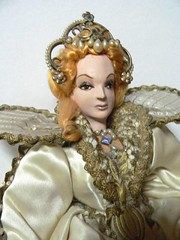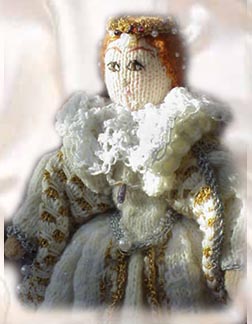The "Virgin Queen" and her court have been the subject of numerous books, films, and doll portraits. Michael Best writes "Living in a conservative society, in which both tradition and religion proclaimed the natural inferiority of women, Elizabeth used her sex to advantage by creating a personal myth that raised her above the ordinary."
This myth not only garnered her the worship of courtiers and commoners alike but influenced both literary artists and historians or her day. "In drama, several plays were written specifically to glorify the Queen: Lyly's Endymion (1588) personifies Elizabeth as Cynthia, chaste and unattainable goddess of the moon; Peele's The Arraignment of Paris (1589) dramatizes the choice Paris had to make between the goddesses of power, fame and love, but in this version he turns instead to the Queen sitting in the audience and gives the golden apple to her," Best reports.
"In poetry, the line ("Queen and huntress, chaste and fair") is from a poem by Ben Jonson included in his Court masque, Cynthia's Revels-- in which, again, the Queen is figured as the goddess of the moon. Also spectacular as a tribute was Spenser's epic, The Faerie Queene, in which Queen Elizabeth is represented in allegorical form by several different characters."
Thomas Weelkes even wrote a song in which the fair Oriana lured the Vestal Virgins away from the goddess Diana.
As Vesta was from Latmos hill descending,
She spied a maiden queen the same ascending,
Attended on by all the shepherds swain,
To whom Diana's darlings came running down amain,
First two by two, then three by three together,
Leaving their goddess all alone, hasted thither;
And mingling with the shepherds of her train,
With mirthful tunes her presence entertain.
Then sang the shepherds and nymphs of Diana,
Long live fair Oriana!
 With
all this attention throughout history, it is not surprising that I found
so many different reincarnations of Elizabeth
in the doll world. Probably my most rare Queen Elizabeth doll is a portrait
doll by Ilse Ottenberg. Ilse and her German husband, Richard, were interned
as enemy aliens on the Isle of Man at the outbreak of World War II. To
occupy their time there, the Ottenbergs began making toys
With
all this attention throughout history, it is not surprising that I found
so many different reincarnations of Elizabeth
in the doll world. Probably my most rare Queen Elizabeth doll is a portrait
doll by Ilse Ottenberg. Ilse and her German husband, Richard, were interned
as enemy aliens on the Isle of Man at the outbreak of World War II. To
occupy their time there, the Ottenbergs began making toys  and soon involved
other internees in their work. After the war, the Ottenbergs turned toy
making into their primary livelihood. At the time of Queen Elizabeth
II's
coronation, Ilse submitted a commemorative doll to Buckingham Palace
for the Queen's approval for a franchise of dolls depicting the Royals
and
was one of only two dollmakers who were granted the license. Ottenberg's
dolls are highly detailed. Even the heeled shoes Elizabeth I wears are
carefully hand stitched.
and soon involved
other internees in their work. After the war, the Ottenbergs turned toy
making into their primary livelihood. At the time of Queen Elizabeth
II's
coronation, Ilse submitted a commemorative doll to Buckingham Palace
for the Queen's approval for a franchise of dolls depicting the Royals
and
was one of only two dollmakers who were granted the license. Ottenberg's
dolls are highly detailed. Even the heeled shoes Elizabeth I wears are
carefully hand stitched.
In an article about Ilse's dolls in the June/July 1985 issue of Doll
Reader, author Nellie Roberts points out that  Ottenberg
dolls have been displayed at a number of British Embassies throughout
the world. I feel very fortunate to have obtained one of these dolls on
Ebay for a price of only $80. I continue to search for them (especially
her Cleopatra or Nefertiti dolls).
Ottenberg
dolls have been displayed at a number of British Embassies throughout
the world. I feel very fortunate to have obtained one of these dolls on
Ebay for a price of only $80. I continue to search for them (especially
her Cleopatra or Nefertiti dolls).
In addition to my beautiful knitted version of Queen Elizabeth created by a very talented Janet Oliver, I obtained one of Janet's first efforts at a Barbie repaint redressed as the famous queen. Janet lives in Anchorage, Alaska. I have been very fortunate to obtain two other knitted dolls from her as well--Henry VIII and an Egyptian priest. They will be featured on other pages within this site. These knitted works of art are created from patterns described in "Knitted Historical Figures" by Jan Messent.
 Janet's
Elizabeth Barbie is lavishly decorated with pearls, a trademark of the
this warrior queen. Sir Roy Strong in his book "The
Portraits of Elizabeth" writes, "There was considerable
attention given to the clothes and jewels Elizabeth wore in portraits.
The Queen's favourite colours were black and white - these also being
'her colours' worn by her knights. In many of the portraits of her in
middle age she is depicted in black with pearls draped across her bodice
and a diaphanous veil pulled around her. Contemporary commentators commented
on how well her black and white clothes complemented her red-gold hair.
An inventory of the Queen's extensive wardrobe compiled in 1600 lists
dozens of 'white satten' robes and 'blacke vellat cloakes' like the dress
in the 'Kitchener' portrait. Her jewellery collection was vast and portraits
often depict her covered in chains, pendants, pearls, rings, brooches
and bracelets. She is often seen wearing enormous rubies and the famous
black pearls which had belonged to Mary Queen of Scots whose colour was
described as being 'like that of muscat grapes'. Whilst it is not rare
for members of the Royal family to be painted wearing jewellery Francis
Bacon suggested that there was another reason at play:
Janet's
Elizabeth Barbie is lavishly decorated with pearls, a trademark of the
this warrior queen. Sir Roy Strong in his book "The
Portraits of Elizabeth" writes, "There was considerable
attention given to the clothes and jewels Elizabeth wore in portraits.
The Queen's favourite colours were black and white - these also being
'her colours' worn by her knights. In many of the portraits of her in
middle age she is depicted in black with pearls draped across her bodice
and a diaphanous veil pulled around her. Contemporary commentators commented
on how well her black and white clothes complemented her red-gold hair.
An inventory of the Queen's extensive wardrobe compiled in 1600 lists
dozens of 'white satten' robes and 'blacke vellat cloakes' like the dress
in the 'Kitchener' portrait. Her jewellery collection was vast and portraits
often depict her covered in chains, pendants, pearls, rings, brooches
and bracelets. She is often seen wearing enormous rubies and the famous
black pearls which had belonged to Mary Queen of Scots whose colour was
described as being 'like that of muscat grapes'. Whilst it is not rare
for members of the Royal family to be painted wearing jewellery Francis
Bacon suggested that there was another reason at play:

...she imagined that the people, who are much influenced by externals,
would be diverted by the glitter of her jewels, from noticing the decay
of her personal attractions.
Marin, a dollmaker in Chiclana, Spain most noted for their dolls depicting
flamenco dancers, also produced historical costume dolls, especially a
line of higher-priced collectible dolls for the House of Lloyderson. Even
their historical dolls often  have
the broad smile of one of Marin's dancers and their hands are usually
in the same expressive pose. However, this rendition of Elizabeth draped
in her trademark pearls was more subdued although the queen would have
approved of the hands. Sir Roy Strong observes, "The Queen was particular
proud of her hands and contemporary accounts describe her making much
of taking her gloves off and often she is posed in portraits with her
hands gesturing or resting in front of her chest."
have
the broad smile of one of Marin's dancers and their hands are usually
in the same expressive pose. However, this rendition of Elizabeth draped
in her trademark pearls was more subdued although the queen would have
approved of the hands. Sir Roy Strong observes, "The Queen was particular
proud of her hands and contemporary accounts describe her making much
of taking her gloves off and often she is posed in portraits with her
hands gesturing or resting in front of her chest."
Of course the House of Nisbet produced several versions of this monarch,
possibly the most famous Queen of England. Elizabeth was very particular
about her portrait so I  wonder
if she would have approved? Strong writes, "Her policing and concern
over her image was reflected in the Privy Council's order in 1596 to destroy
all portraits of her which were to her 'great offence'. Sir Walter Raleigh
in The History of the World of 1687 describes the works of 'common Painters'
being thrown in the fire. As a result we are justify with a smaller number
of iconic portraits; interesting because of their fine quality and because
they survived the Queen's rigorous editing. We are presented with images
of the Queen fashioned in the way she wished to be presented and make
her unmistakable."
wonder
if she would have approved? Strong writes, "Her policing and concern
over her image was reflected in the Privy Council's order in 1596 to destroy
all portraits of her which were to her 'great offence'. Sir Walter Raleigh
in The History of the World of 1687 describes the works of 'common Painters'
being thrown in the fire. As a result we are justify with a smaller number
of iconic portraits; interesting because of their fine quality and because
they survived the Queen's rigorous editing. We are presented with images
of the Queen fashioned in the way she wished to be presented and make
her unmistakable."
- A pale Roman nose, a head of hair loaded with crowns and powdered with diamonds, a vast ruff, a vaster fardingdale, and a bushel of pearls, are the features by which everybody knows at once the pictures of Elizabeth I" - Horace Walpole
Collecting Historical Dolls.....The French Court......Early Britain...Medieval Britain...The Tudors....Mary's Home Page
- This page designed and created by Mary
Harrsch
- All images copyright 2003.

This work is licensed under a Creative Commons Attribution-NonCommercial-ShareAlike 2.5 License.
- Last updated:
01/09/2007 - All images copyright 2003.
Elizabethan Dolls
from Mary's
Historical Doll Collection and exhibits I have seen